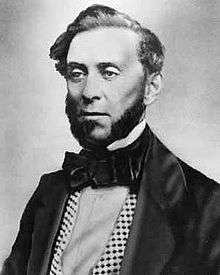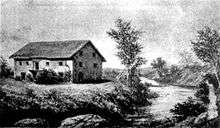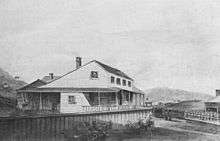Samuel Brannan
| Samuel Brannan | |
|---|---|
 Samuel Brannan | |
| Born |
March 2, 1819 Saco, Maine, United States |
| Died |
May 5, 1889 (aged 70) Escondido, California, United States |
| Resting place | Mount Hope Cemetery, San Diego, California, United States |
| Religion | Mormon; Church of Jesus Christ of Latter-Day Saints |
| Spouse(s) | Anna Eliza Corwin |
| Children |
|
Samuel Brannan (March 2, 1819 – May 5, 1889) was an American settler, businessman, journalist, and prominent Mormon who founded the California Star, the first newspaper in San Francisco, California. He is considered the first to publicize the California Gold Rush and was its first millionaire.[1]:237 He helped form the first vigilance committee in San Francisco. He used the profits from his stores and possibly the tithes contributed to him as a leader of the LDS church to buy large tracts of real estate. When he could not account for the tithes given him, he was disfellowshipped from the LDS church. His wife divorced him and he was forced to liquidate much of his real estate to pay her one-half of their assets. He died poor and in relative obscurity.
Early life
Brannan was born in Saco, Maine, to Thomas and Sarah Emery Brannan, about a year before its independence from Massachusetts. Because of problems with his abusive father, when he was fourteen years old he moved with his sister (Mary Ann) and her husband (Alexander) to Painesville, Ohio. It was there that Brannan learned the printer's trade.[2]:22–24 During their journey to Ohio, the trio found themselves listening to two men whom they would later know as Orson Hyde and Heber C. Kimball. Brannan's brother-in-law bought a copy of the Book of Mormon from these street corner missionaries. In the neighboring town of Kirtland, Ohio, Brannan, Alexander, and Mary Ann all joined the Church of Jesus Christ of Latter Day Saints in 1842.[3]:15 After his father's death, Brannan inherited a decent sum of money, bought himself out of his last year of his apprenticeship, and invested the rest in a patch of land near Cleveland. Soon after making his investment and hoping to get rich because of said investment, the market crashed and his land was worthless.[1]:237 He made a quick visit to Maine in order to visit his ailing mother and then made his way to New Orleans where his brother Thomas was living. The Brannan brothers bought a press and type with what little money they had, but Thomas was taken by yellow fever shortly thereafter. After this tragedy, Brannan made his way back to the North stopping in Indianapolis to work on the Gazette, but that only lasted for a couple months before he returned back to Painesville.[3]:29–31
Early Service in the Church
Once Brannan had returned to his sister's home, he renewed his religious convictions in the LDS church and was called by the apostle Wilford Woodruff to serve a local mission in Ohio.[3]:34–36 Before being called as a missionary he had married Harriet ("Hattie") Hatch and they were expecting their first child.[2]:39 His mission ended earlier than expected when he caught malaria and had to return home for his health.[3]:38 Once he had sufficiently recovered he was again called to help the church, but this time as a printer in Connecticut working alongside the apostle William Smith. While waiting in Connecticut to meet-up with Smith, Brannan fell in love with Ann Eliza Corwin whose mother took care of the visitors in the local boarding house and planned to marry her and separate from his first wife.[3]:40
From Connecticut they went to New York City, New York, in 1844, and began printing The Prophet (later The New-York Messenger), a Latter Day Saint newspaper. Shortly after the paper began, news spread that the prophet Joseph Smith and his brother Hyrum were murdered and Brigham Young had taken over the position as prophet. Because Brannan worked so closely with Smith's blood brother William, he began advocating for William to take his "rightful place" as prophet. After word of Brannan and Smith's opposition reached Nauvoo both men were disfellowshipped from the church.[3]:43–45 A year later, Brannan went to the Quorum of the Twelve Apostles pleading for reinstatement as a member of the church; it was granted in May 1845.[3]:46
Travel to California
After the death of Joseph Smith and with rising opposition in the west, the Saints decided to relocate their center from Nauvoo, Illinois to a region outside of the borders of the United States.[3]:47 Several possible destinations were discussed, including the Mexican territory of Alta California. On February 4, 1846, with the approval of church leaders, Brannan and 238 other Latter Day Saints from New York set sail aboard the ship Brooklyn for upper California via Cape Horn.[3]:58 Brannan had an antiquated printing press and a complete flour mill on board. After a stop in Honolulu, Hawaii, they landed, on July 31, 1846, at the Mexican port town of Yerba Buena, present-day San Francisco, tripling the population of the pueblo.[1]:237[3]:71 After settling in Yerba Buena, Samuel consulted with natives who were familiar with the region and decided that the land down by the Sacramento River, which they named "New Hope", would be the next Nauvoo of the saints, but with real refuge and religious freedom. After disputes between members over land and other affairs, the city of "New Hope" quickly failed.[3]:80 Brannan is often accredited to have been the first to perform certain actions: a non-Catholic wedding ceremony, the first to preach in English, and the first to set-up a California public school and a flour mill.[1]:239 Brannan was appointed as the first mission president of the California LDS Mission.
California career
Brannan used his press to establish the California Star as the first newspaper in San Francisco, which released its first formal issue on January 9, 1847.[3]:82 It was the second paper in California, following The Californian founded in Monterey and first published on August 15, 1846. The two joined to become The Daily Alta California in 1848.[4]
In June 1847, Brannan traveled overland to Green River, Wyoming, to meet with Brigham Young, the head of the Church of Jesus Christ of Latter-day Saints, who was leading the first contingent of Mormon pioneers across the plains to the Great Basin region. Brannan urged Young to bring the Mormon pioneers to California but Young rejected the proposal in favor of settling in what is present-day Utah. Brannan returned to northern California.[3]:103–107
California Gold Rush

Early in 1848, employees of John Sutter paid for goods in Brannan's store with gold they had found at Sutter's Mill, near Coloma, California. Being the only church leader of that region, Brannan continued to receive tithes of the church members, but no records have been found showing that those tithes were forwarded to the leaders of the church in Utah. Many members stopped paying him and began making their way eastward toward Zion.[3]:165–166 His California Star paper could not publish the news of the gold strike as the staff had already left for the gold fields. "Brannan moved to New Helvetia, where he opened a store at John Sutter's Fort. When gold was discovered, Brannan owned the only store between San Francisco and the gold fields -- a fact he capitalized on by buying up all the picks, shovels and pans he could find, and then running up and down the streets of San Francisco, shouting "Gold! Gold on the American River!" He paid 20 cents each for the pans, then sold them for $15 apiece. In nine weeks, he made $36,000."
San Francisco and Sacramento

In 1848, Brannan decided that he was going to use all of his resources in order to help build-up California and its connection with the east. He planned on building that connection through the California Star Express, which would deliver mail from San Francisco to Independence, Missouri and had its first route on April 1, 1848.[3]:122 Brannan had opened more stores to sell goods to the miners (his Sutter Fort store sold US$150,000 a month in 1849), and began buying land in San Francisco. He also acquired all of the remaining assets of the failed "New Hope" project and like many other saints at this time, found his focus had turned from church affairs to monetary gains.[3]:124
Using his profits and possibly the proceeds of tithing paid to him as a LDS church representative, Brannan bought land from Sutter in the Sacramento area. In 1847, he opened a store at Sutter's Fort, in present-day Sacramento, California.[1]:239 He also built many large buildings in both Sacramento and San Francisco. Around this same time Brannan established ship trade with China, Hawaii, and the east coast. His land holdings extended to southern California and to Hawaii where, in 1851, he visited and purchased large amounts of land in Honolulu.[3]:173 He and other landowners and speculators raised the price of land considerably, angering many. The disagreement escalated during 1850 into the Squatters' Riot, during which the squatter's spokesman, Doctor Charles L. Robinson, was shot, along with others. Some allege he was shot by Brannan and put in jail with his wound untreated. Nine people were killed. Brannan was considered the instigator of the incident.[5]:125-127
Brigham Young sent the apostle Amasa Lyman to collect the tithing money that Brannan had withheld from the church. When Lyman arrived Brannan was unable to account for the tithes given him, and reportedly told them, "You go back and tell Brigham Young that I'll give up the Lord's money when he sends me a receipt signed by the Lord",[6] although historians, such as Will Bagley have found this is likely just legend.[7][8] Following this incident Brannan was disfellowshipped from the LDS Church.[3]:173–175
Brannan became California's first millionaire.[3]:173 In 1853, he was elected as a Senator to the California State Senate in the new state's capital of Sacramento.[3] :179 Brannan was elected to the first town council of San Francisco in the new U.S. territory. In 1851, after a series of sensational crimes in the area, he helped organize and was the first president of the San Francisco Committee of Vigilance, which functioned as a de facto police force.[1]:240 He was involved in developing trade with China and financial agreements with Mexico, founding the Society of California Pioneers, and developing banks, railroads and telegraph companies in California. In 1858, Brannan built the first incarnation of the famous Cliff House on the Pacific Ocean in undeveloped western San Francisco.
In order to continue the settlement of the west, Brannan purchased California's first steam locomotive in an effort to hasten the building of the first western railroad. He also teamed up with other local capitalists to construct the first wharf in San Francisco. Around this same time Brannan made know his feelings about slavery and spoke out against it.[3]:177
On July 11, 1851 Parley P. Pratt and his mission companions ventured to San Francisco to establish the Pacific Mission of the LDS church. He invited Brannan and his family to take part in meetings and to once again join the saints, but Brannan had a different life and different objectives. He was officially, yet quietly disfellowshipped by Pratt after multiple attempts to bring him back to the church. [3]:192
Calistoga
After Brannan visited the hot springs in the upper Napa Valley in 1859, he planned a new resort for the area. He bought land containing the springs in the northern portion of the Rancho Carne Humana in 1861and founded the town of Calistoga, said to be a combination of the words "California" and then-fashionable Saratoga Springs in New York. Brannan also founded the Napa Valley Railroad there in 1864 in order to provide tourists with an easier way to reach Calistoga from the San Francisco Bay ferry boats that docked in the lower Napa Valley at Vallejo. The railroad was later sold at a foreclosure sale in Napa County in 1869.[3]:217 Many poorer Calistoga residents were angered by Brannan's take-over of the region. At one point the opposition was so intense that Brannan and a couple others were shot at. Because of the incident, Brannan used a cane for the rest of his life. [3]:224
In 1868, Brannan became one of the principal investors in the Robinson Trust which purchased and initiated development of the major coastal Los Angeles County land holdings of Californio Abel Stearns, near the San Pedro Bay in Southern California.
In 1870, Anna Eliza Corwin divorced Brannan. They had grown apart as Eliza lived in Europe for quite some time while Brannan remained in California. Because of the divorce he lost much of his personal fortune after his divorce, as it was ruled that his wife was entitled to half of their holdings, payable in cash. Because the vast majority of Brannan's holdings were in real estate, he had to liquidate the properties to pay the full divorce settlement.[3]:227
Southern California
Following the divorce, he became a brewer and developed a problem with alcohol. Forsaking the city he helped develop into San Francisco, he drifted south to Mexico and remarried. He set up a small ranch near the Mexican border in the state of Sonora.[3]:238 This is where his newly acquired tract of land was located, which was given to him by President Juárez and the Mexican government after helping them expulse the unwanted French from Mexican lands.[1]:241–242 In 1888, at the age of sixty-nine, he was paid the sum of forty-nine thousand dollars in interest from the Mexican government. He quit drinking and paid all his debts, but he died without leaving enough money to pay for his own funeral.
Death and legacy
He probably did more for [San Francisco] and for other places than was effected by the combined efforts of scores of better men; and indeed, in many respects he was not a bad man, being as a rule straightforward as well as shrewd in his dealings, as famous for his acts of charity and open-handed liberality as for in enterprise, giving also frequent proofs of personal bravery.[9]
Brannan died at age 70 in Escondido, California, Sunday, May 5, 1889, from inflammation of the bowels.[10] Brannan's body lay unclaimed in the San Diego County receiving vault for over a year until it was recognized by chance. He was given a Christian burial though, for many years, only a stake marked his grave.[3]:249-250 He is interred in Mount Hope Cemetery.[11]
Legacy
- Many locations in California are named after Brannan, including Brannan Street in San Francisco, Brannan Island, Brannan Bluff (Table Bluff), Brannan Creek, Brannan Mountain, Brannan Springs, and Brannan River. There is also a Sam Brannan Middle School in Sacramento.[12]
- California cities that claim Brannan as their founder include Calistoga and Yuba City.
- In partnership with John Augustus Sutter, Jr. and with William Tecumseh Sherman and Edward Ord as surveyors, Brannan laid out the unofficial subdivisions that became the city of Sacramento.
See also
References
- 1 2 3 4 5 6 7 Hunt, Rockwell D. (1950). California's Stately Hall of Fame. Stockton, California: The College of the Pacific. pp. 237–242.
- 1 2 Scott, Reva (1944). Samuel Brannan and the Golden Fleece. New York: The Macmillan Company.
- 1 2 3 4 5 6 7 8 9 10 11 12 13 14 15 16 17 18 19 20 21 22 23 24 25 26 27 Bailey, Paul (1943). Sam Brannan and the California Mormons. Los Angeles, California: Westernlore Press.
- ↑ Breschini, Gary S. (2000). "The First Newspaper in California". Monterey County Historical Society. Retrieved January 22, 2009.
- ↑ Stellman, Louis J. (1953). Sam Brannan: Builder of San Francisco. New York: Exposition Press. ISBN 1885852053.
- ↑ Quinn, Arthur (1997), The Rivals: William Gwin, David Broderick, and the Birth of California, University of Nebraska Press, p. 38
- ↑ Bagley, Will, "Latter-day Scoundrel Sam Brannan", Wild West
- ↑ Bagley, Will (1999), Scoundrel's Tale: The Samuel Brannan Papers, Spokane, Washington: Arthur H. Clark Company, ISBN 0-87062-287-0
- ↑ Bancroft, H. H. California pioneer register and index, 1542-1848 (Baltimore : Regional Pub. Co., 1964), 68.
- ↑ "Sacramento daily record-union. (Sacramento [Calif.]) 1875-1891, May 07, 1889, Page 2, Image 2".
- ↑ Samuel Brannan at Find a Grave
- ↑ Sam Brannan Middle.
Bibliography
- Bagley, Will. "'Every Thing Is Favourable! And God Is on Our Side': Samuel Brannan and the Conquest of California." Journal of Mormon History 23, no. 2 (1997): 185–209.
- Bagley, Will, ed. Scoundrel's Tale: The Samuel Brannan Papers. Spokane, WA: Arthur H. Clark, 1999. ISBN 0-87062-287-0. (Also published by Utah State University Press.)
- Bringhurst, Newell G. (Summer 1997), "Samuel Brannan and His Forgotten Final Years", Southern California Quarterly, 79: 139–60, doi:10.2307/41171850.
- Campbell, Eugene E. (April 1959), "The Apostasy of Samuel Brannan", Utah Historical Quarterly, 27 (2): 156–67.
- Dickson, Samuel. Tales of San Francisco. Stanford: Stanford University Press, 1957.
- Luce, W. Ray (August 1968), Samuel Brannan: Speculator in Mexican Lands, Master's thesis, Provo, Utah: Department of History, Brigham Young University.
- Scott, Reva Lucile Holdaway (1944), Samuel Brannan and the Golden Fleece (2nd ed.), New York: Macmillan.
External links
- PBS - The West - Samuel Brannan
- based on a San Diego Union article, republished in Sacramento Bee
- California Gold Rush Profile - 1st millionaire dies broke
- California Newspaper Hall of Fame - Sam Brannan
- Historynet.com/ Latter Day Scoundrel
- Samuel Brannan papers, MSS 5920 at L. Tom Perry Special Collections, Brigham Young University